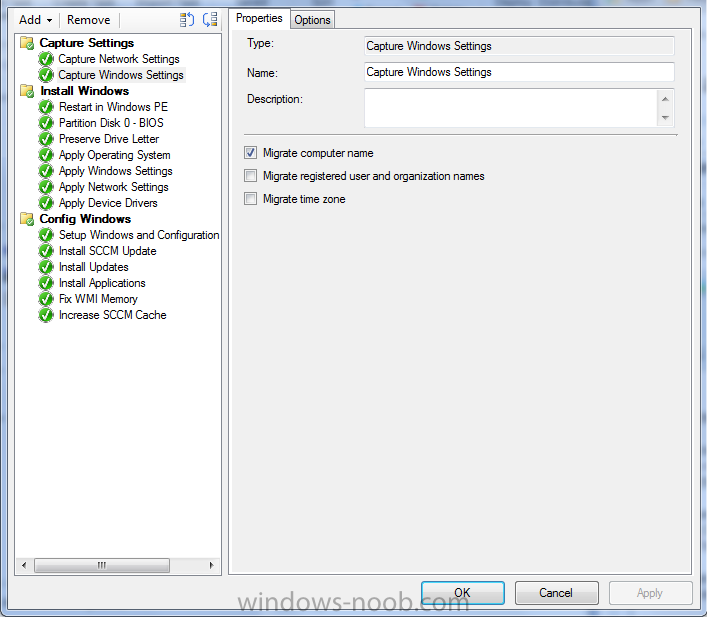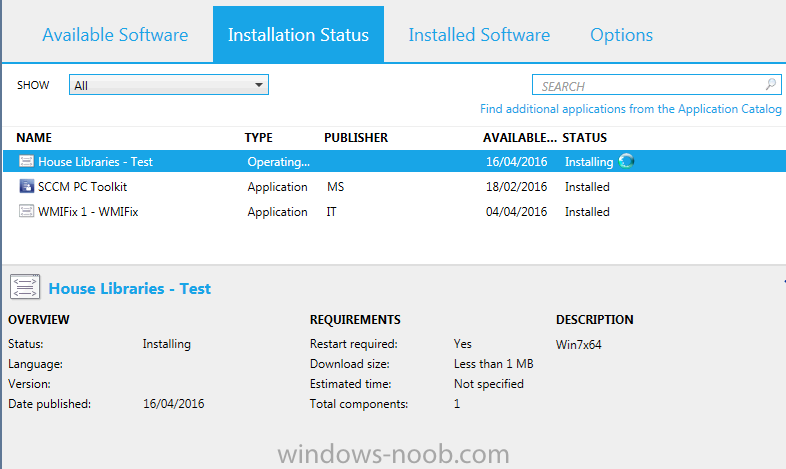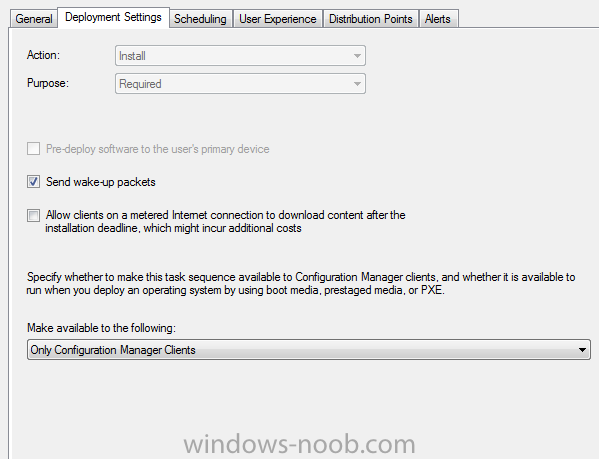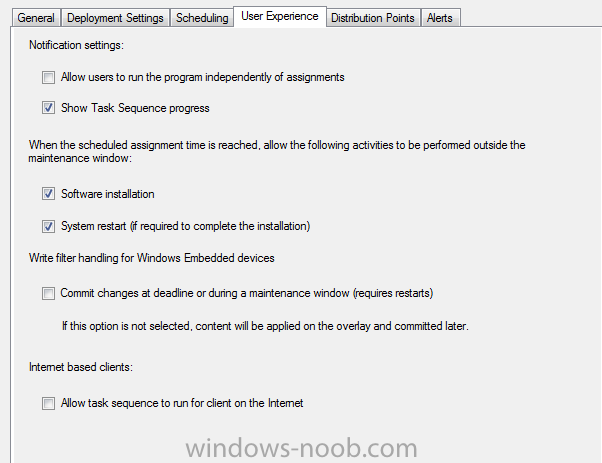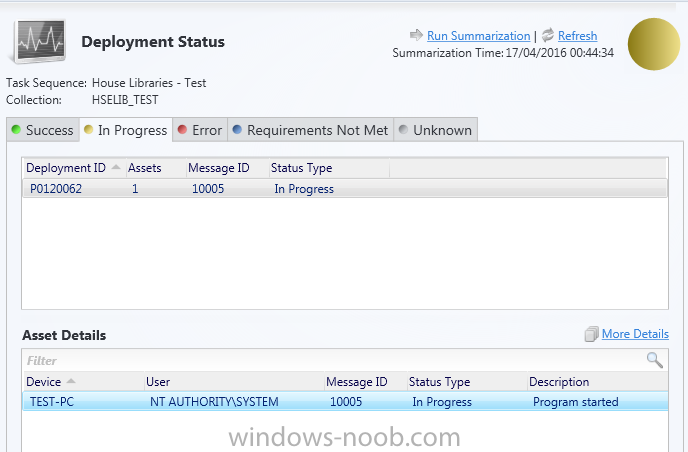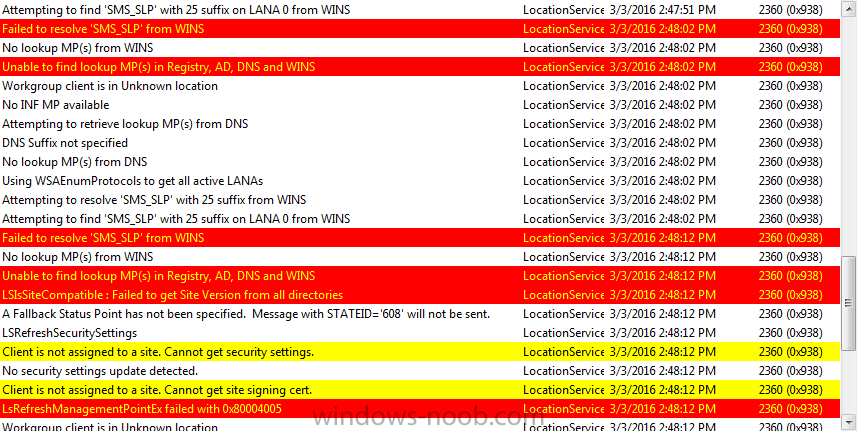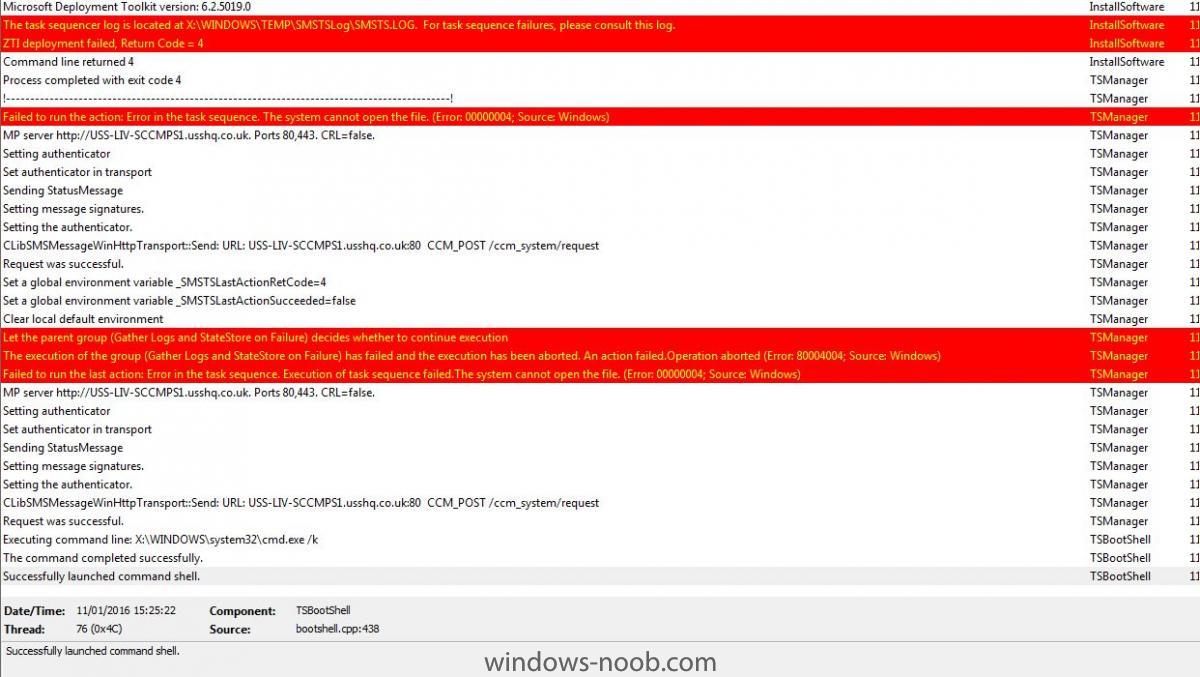Search the Community
Showing results for tags 'osd'.
-
Good afternoon, I have a windows 10 task sequence that lays down the OS nicely, installs all drivers, and activates windows/etc. We have kept fairly strict on standardizing the models of laptops/desktops that we purchase for our school district. We have a group of Lenovo T420 laptops that images perfectly with Windows 7 x86, but we just received a new batch and we're going to push Win10 x64 Professional to them. When getting the first one imaged, I noticed there were 4 or 5 drivers the task sequence did not take care of. I manually downloaded them, some of them only listed compatible with Windows 7 x64, but they worked fine with Win 10 x64, no issues whatsoever. I added those drivers to my sccm server, added them to my "x64 Lenovo Laptops" Driver Package, and updated them on my distribution point. I noticed when I right click the driver and go to the "Applicability" tab, it only had Windows 7 (64-bit) checked. I made sure Windows 10 Professional/Enterprise and higher (64-bit) was selected and even did 32-bit as well, applied, updated my distribution points, and I reran my OSD task sequence. Two drivers remain uninstalled after running the task sequence. 1) Base System Device, which is Ricoh PCIe SDXC/MMC Host Controller and 2) Intel® Active Management Technology - SOL I've double checked, readded the drivers to the packages/server, updated my distribution points and it does the same thing, only those two drivers WILL not install. What am I missing? Any help is appreciated, thank you!
-
Hello, I need to create a prestaged image that I will store on a hard drive for our hardware vendor to have the image already applied on the computers when they arrived to our institution. Then the process will just continue with the rest of the task sequence steps once they arrive onsite. Can someone explain or point me to a written guide on how to accomplish this? Can the prestaged image be set to expire after x amount of time? Thanks in advance.
-
I'm want to make a new task sequence to OSD, without MDT, but I wanna to avoid to have too many task sequence. Problem: each department has his own software but sometimes they are common in other departments. And then I have the OU's for each department. I'm going to try something like this: Goal: one single task sequence, instead of having 10 or 20... For software: declare a variable in a collection where that variable is something like "BundleSoftware_1 = true". In the task sequence, if this variable is true, then install the applications bundle; For OU's, I would do the same. A will declare the same variable for several collection (department A, department B, department C, etc). If variable = RH, then would match the step where it registers the computer in RH OU. I never did this, but I would like to know if anyone has setup something like this. Any other ideas would be great! Thanks in advanced!
-
Hi All Credit to the author of this site, its fantastic knowledge. 1up! I have recently been tasked to re-image 45 PCs across several sites in the next 24 hours. I was hoping to run a unattended OSD (SCCM 2012 CU3) which would capture the PCName / Domain settings and apply our new (fat) image (55GB). Now I have captured the image that I want and I have created an OSD for my choosen collection. The OSD Deploys to the collection but I find that OSD is stuck at "Installing" status for the past couple of hours with a reboot in sight. I have used CMTrace on the old PC and Server but none of error relate to the time its was launch. The only error I had was network access account which has now been fixed. Please could someone offer some advice on what I should be looking for? Thank you ixpnet I have attached a couple of photo of my setup. Happy to upload logs if needed.
-
Hi - I need some advice about where to search or what log to look at.... all of a sudden my Task Sequences for OSD are delayed in becoming available. For example: I deploy a TS to a collection but then when I boot, that TS isn't available for about a half hour and sometimes up to an hour. I have Googled Task Sequence logs, but I can't seem to find a log for just the process of deploying the TS to a collection, not the actual OSD itself. Any help would be appreciated. Jodi
-
Hello, Is there any way to remove/hide/encrypt passwords appearing in clear text in the client-side logs during OSD? During OSD, i can read out domian, useraccount and password for the Client Network Access Account. This account have read on the packages share,and i dont want people deploying computers all over the world beeing able to read from the share. I think i read something about this in the realease notes for 1511, but i cant find it again. Hope someone else have done this, and can spare the time to give me the solution Best Regards Marius Senior IT-Consultant
-
Hi, the build in report "User device affinity associations per collection" doesn´t list the "OSD Defined" relationships. We are using powershell to import computers and set the UDA relationship with the following command: Invoke-WmiMethod -Namespace root/SMS/site_$($SiteCode) -Class SMS_UserMachineRelationship -Name CreateRelationship -ArgumentList @($WksResourceID, 6, 1, $User) -ComputerName $SiteServer The console shows the relationship and software deployment works well. If we change the parameter "source" from "6" (OSD Defined) to "2" (Administrator Defined) the report lists the relationship correctly. Any ideas? Best regards
-
- uda
- user device affinity
-
(and 4 more)
Tagged with:
-
Good Morning All / Niall - I'm setting up a Windows 7 x64 Pro OSD TS in a new 1511 environment and am stuck on something. I'm set up numerous OSD TS's before, but this is my first with 1511. Everything goes well until it gets to the step where the client is installed & configured where it stays there for probably 10-15 minutes. Eventually, it reboots then goes to the next step which still shows a message about the client on the 2nd progress bar then fails. When I log into Windows (after it reboots from the failure), the domain is joined and I may log in with domain credentials. I launch the SCCM Client properties in Control Panel and see that there's no site selected nor client certificate. I did find that if I manually enter the site code into the client under the "Site" tab, it immediately finds the site and connects to it. What I've Tried / Examined I've tried a few different things - all with the same results - including building a new client package from scratch using the steps in Niall's famous guides, and using in the task sequence; using the SMSMP string in the client properties of the TS, and examining log files. Even though I see a couple of errors in the ccmsetup.log, the client seems to physically installs fine and exits with code 0. When looking at LocationServices.log, I see a few things, though: In case the screenshot doesn't come through... Failed to resolve 'SMS_SLP' from WINS Unable to find lookup MP(s) in Registry, AD, DNS and WINS LSIsSiteCompatible : Failed to get Site Version from all directories Client is not assigned to a site. Cannot get site signing cert. LsRefreshManagementPointEx failed with 0x80004005 Client is not assigned to a site. Cannot refresh Local MP. Client is not assigned to a site. Cannot get portal info. The above loops amongst a few information messages Any ideas or suggestions to what this may be? I've got to get all of this working today! Thanks!
-
Hi, I recently have taken on the challenge of creating and deploying images within my company. Everything seems to be going ok, minus a couple GP objects not applying... Within my TS, I have it set to generate a local admin account with a generic PW to use in case I need to get into the machine. Once domain joined, and I log into my domain/admin account ok, and run a GP update. We have 3 local admin/service accounts that should be populating within the users/groups sections. However, they are not doing so. When I look at the event viewer logs under GP, there are no errors, warnings, etc.. Stating that everything is ok, finds objects, pulls objects down ok... Is there something else I can look at, or something I may have missed? I've attempting to search the net, but it mostly points to "how to" within a GPO template. I really need to get a lid on this one, any help/direction is greatly appreciated. Thank you ,
-
- Group Policy
- OSD
-
(and 1 more)
Tagged with:
-
Hello, I got 2 almost the same enviroments both upgraded to the latest version of sccm. 1 can easy add OSD and there is no problem the other enviroment is refusing adding the OSD i tried already existing OSD and new ones but all fails. i get the following error massage "The spicifed unc path does not contain a valid WIM file or you do not have permissions to acces it. specify a valid path" I try to add it by netwerk share, the server and netwerk acces account got full persmision to acces the share and folders under it. the more strange is that in my other enviroment the OSD addes perfectly no problems found. ive i try to ad an application there is no problemen and that also works fine, how can i troubleshoot on what point exactly the sccm refusing to add the OSD Version 5.0.8239.1302 SCCM 2012 r2 sp1 CU2 ADK version 8.1
-
Hello all! I've been trying to deploy Windows 7 64-bit to our new HP EliteDesk 800 65W G2 Desktop Mini PC. All goes OK up to apply operating system step (error occurs at the end of apply OS step). After downloading and applying OS.wim to C-drive, i get following errors to smsts.log: _________________________________________________________________________ Failed to save environment to (80070057) TSManager 28.1.2016 12:08:23 1348 (0x0544) Failed to save the current environment block. This is usually caused by a problem with the program. Please check the Microsoft Knowledge Base to determine if this is a known issue or contact Microsoft Support Services for further assistance. The parameter is incorrect. (Error: 80070057; Source: Windows) TSManager 28.1.2016 12:08:23 1348 (0x0544) Failed to persist execution state. Error 0x(80070057) TSManager 28.1.2016 12:08:23 1348 (0x0544) Failed to save execution state and environment to local hard disk TSManager 28.1.2016 12:08:23 1348 (0x0544) _________________________________________________________________________ After these errors there are other inputs in log, but I believe OSD failing is about these errors. When I try and start computer (in which OSD has failed) I get error: "An operating system wasn't found. Try disconnecting any drives that don't contain an operating system. Press Ctrl+Alt+Del to restart" Any ideas why I'm getting these errors and how can I fix them? Thanks!
- 7 replies
-
- sccm 2012 r2
- osd
-
(and 3 more)
Tagged with:
-
hello, im after some assistance if possible. Im attempting to deploy a windows 10 image, i have created a reference image from within MDT then imported the WIM in SCCM 2012 r2 sp1 Cu2. I have built a new mdt task sequence within SCCM 2012 and have downloaded the windows 10 drivers for the surface pro 4. The image deploys to a virtual machine fine and joins it to the network, but im having trouble with the Surface pro. Sometimes it finishes installing drivers and then hangs on "getting ready"... other times it completes the osd but it hasn't joined the network. There is a step in the task sequence to apply the surface pro 4 drivers and it seems to run through that ok, there is also another step to automatically apply drivers which i have switched on at present... like i said the osd completes on a vm but not my surface pro 4.... cant figure out the exact step that fails the whole OSD ive attached the SMSts.log from the surface.... i can see it doesnt find all the drivers but was hoping it would be enough to enable the OSD to complete. any help would be appreciated. smsts.log
-
Is it possible after choosin' the image to create an prompt to let you choose which application want to add in your image. After that comes the OSDComputername.
-
I have made a task to update drivers for a lenovo E550 Laptop. First task: command line (Run ThinINstaller TrustZone) cmd /c C:\Windows\Microsoft.NET\Framework\v4.0.30319\CasPol.exe –pp off –m –ag 1.2 –url file://\\x.x.x.x\Sources\os_drivers\Laptops\E550\ FullTrust Disable 64-bit file systems redirection Second task: command line (CMD Copy ThinInstaller) cmd /c xcopy.exe "\\x.x.x.x\Sources\ThinInst\*.*" C:\Thinstaller\ /E /D Time-outs: 15 minutes Third Task: command line (CMD Run ThinInstaller) cmd /c C:\Thinstaller\thininstaller.exe /CM -search A -action INSTALL -noicon -includerebootpackages 1,2,3,4 -repository "\\x.x.x.x\Sources\os_drivers\Laptops\E550" -log "C:\Thinstaller\tvsulog.txt" Start in: C:\Thinstaller Time-outs: 120 minutes Error: Failed to run the action: Run ThinINstaller TrustZone. Incorrect function. (Error: 00000001; Source: Windows) Expand a string: smsswd.exe /run: cmd /c %windir%\Microsoft.NET\Framework\v4.0.30319\CasPol.exe –pp off –m –ag 1.2 –url file://\\x.x.x.x\Sources\os_drivers\Laptops\E550\ FullTrust TSManager 1/11/2016 7:16:25 PM 268 (0x010C) Expand a string: TSManager 1/11/2016 7:16:25 PM 268 (0x010C) Command line for extension .exe is "%1" %* TSManager 1/11/2016 7:16:25 PM 268 (0x010C) Set command line: smsswd.exe /run: cmd /c %windir%\Microsoft.NET\Framework\v4.0.30319\CasPol.exe –pp off –m –ag 1.2 –url file://\\x.x.x.x\Sources\os_drivers\Laptops\E550\ FullTrust TSManager 1/11/2016 7:16:25 PM 268 (0x010C) Start executing the command line: smsswd.exe /run: cmd /c %windir%\Microsoft.NET\Framework\v4.0.30319\CasPol.exe –pp off –m –ag 1.2 –url file://\\10.160.14.25\Sources\os_drivers\Laptops\E550\ FullTrust TSManager 1/11/2016 7:16:25 PM 268 (0x010C) !--------------------------------------------------------------------------------------------! TSManager 1/11/2016 7:16:25 PM 268 (0x010C) Expand a string: WinPEandFullOS TSManager 1/11/2016 7:16:25 PM 268 (0x010C) Executing command line: smsswd.exe /run: cmd /c %windir%\Microsoft.NET\Framework\v4.0.30319\CasPol.exe –pp off –m –ag 1.2 –url file://\\x.x.x.x\Sources\os_drivers\Laptops\E550\ FullTrust TSManager 1/11/2016 7:16:25 PM 268 (0x010C) [ smsswd.exe ] InstallSoftware 1/11/2016 7:16:25 PM 1168 (0x0490) PackageID = '' InstallSoftware 1/11/2016 7:16:25 PM 1168 (0x0490) BaseVar = '', ContinueOnError='' InstallSoftware 1/11/2016 7:16:25 PM 1168 (0x0490) ProgramName = 'cmd /c X:\WINDOWS\Microsoft.NET\Framework\v4.0.30319\CasPol.exe –pp off –m –ag 1.2 –url file://\\x.x.x.x\Sources\os_drivers\Laptops\E550\ FullTrust' InstallSoftware 1/11/2016 7:16:25 PM 1168 (0x0490) SwdAction = '0001' InstallSoftware 1/11/2016 7:16:25 PM 1168 (0x0490) Set command line: Run command line InstallSoftware 1/11/2016 7:16:25 PM 1168 (0x0490) Working dir 'not set' InstallSoftware 1/11/2016 7:16:25 PM 1168 (0x0490) Executing command line: Run command line InstallSoftware 1/11/2016 7:16:25 PM 1168 (0x0490) Process completed with exit code 1 InstallSoftware 1/11/2016 7:16:25 PM 1168 (0x0490) Command line returned 1 InstallSoftware 1/11/2016 7:16:25 PM 1168 (0x0490) Process completed with exit code 1 TSManager 1/11/2016 7:16:25 PM 268 (0x010C) !--------------------------------------------------------------------------------------------! TSManager 1/11/2016 7:16:25 PM 268 (0x010C) Failed to run the action: Run ThinINstaller TrustZone. Incorrect function. (Error: 00000001; Source: Windows) TSManager 1/11/2016 7:16:25 PM 268 (0x010C) Can anyone help me out?
-
hello, I wonder if anyone can help, im experiencing osd failure. Its not a new task sequence but I have recently upgraded to sccm 2012 r2 sp1 cu2. I have changed the boot image to the new windows 10 pe (x64) on the task sequence. I am deploying a windows 7 x64 image to a new desktop which I have downloaded the drivers for (hp z440) and injected the network and sata disk drivers into the boot image (it previously wouldn't even start windows pe until I did this). Now it pxe boots, I select the task sequence and it gets to a point just after completing the installation of the OS and then fails. errors attached (smsts.log) a few highlights from the log "ZTI deployment failed, Return Code = 4" "Failed to run the action: Error in the task sequence. The system cannot open the file. (Error: 00000004; Source: Windows)" can anyone please help with this? smsts.log
- 2 replies
-
- tasksequence
- sccm2012
-
(and 1 more)
Tagged with:
-
Hello all, I just received a batch of Dell Precision Tower 7810 workstations and I need to get them imaged and deployed. The issue I am having is with the NIC and some odd behavior during OSD and afterward. I have the driver from Dell that came from their system driver pack (http://en.community.dell.com/techcenter/enterprise-client/w/wiki/7556.precision-t7810-windows-7-driver-pack) and it seems to install okay. However, I can't get any of my applications to install during the TS with this driver. I can hit F8 and ping my DP and everything, but nothing will download and install. Once the TS finishes, and the machine boots into Windows, the taskbar shows the NIC as disconnected, but I have a network connection. The machine is added to the domain during the TS without issue. The SCCM client is installed during the TS, but it won't communicate with my management server once booted into Windows. I'm able to ping internally and externally without issue. I saw the comment on the Dell CAB webpage where the user used a newer driver, and I tried that as well with no success. So far, I have tried: the driver that comes in the Dell driver pack the driver download individual from Dell for this model the driver off Intels website the driver I pulled off a computer that came from Dell before I attempted to image with my organizations image All of these drivers exhibit the same behavior. The computer right out of the box using Dells image works fine. Anything done with OSD, and there are problems. I have no issues imaging any other machine whether it be made from Dell or HP For giggles, I installed Windows manually off a USB thumb drive and used the same drivers as above, and everything worked fine. I'm really scratching my head here on this one. I would say there is a problem with my image, but I don't have any issue with any other model across several vendors using the same image, so now I'm really at a loss. None of it really makes any sense at this point. The Dell T7810 uses the Intel I217-LM NIC, which I have other models that use as well, but the T7810 is the only one giving me issues. Any help/advice is greatly appreciated
- 1 reply
-
- OSD
- Precision T7810
-
(and 3 more)
Tagged with:
-
Hi Guys, Happy New Year. Wanted to know if anyone knows best way to configure Dual Monitor settings during Win7 OSD deployment in SCCM 2012 R2 SP1 MDT integrated. I know you can edit the unattended.xml file ( can this be done for two monitors and setting one as main ?). Is there somewhere where the settings are applied in registry that i can export and import at the end of the TS before the final reboot. Basically we have a few Workstations that use dual monitors and the displays need to be configured a certain way, was hoping there was a way to configure this during TS rather than the engineer having to manually configure once complete. any help would be appreciated. Thank you
-
Hi Guys, Our company has just purchased 40 new X1 Carbon Laptops 3rd Gen Model (20BS/BT). We have been having issue finding the correct driver set for this laptop to work with windows 7 deployment. Each time we try to deploy windows 7 to it the task sequence failed, windows 7 get installed without any drivers or applications. Does anyone have any issues deploying windows to this model? What driver are you using for this model? Thanks for your help.
-
Hi Everyone, I am trying to automate MBAM Encryption during the OSD Task Sequence using the "StartMBAMEncryption.wsf" script provided in the following blog. http://blogs.technet.com/b/deploymentguys/archive/2012/02/20/using-mbam-to-start-bitlocker-encryption-in-a-task-sequence.aspx The command I use is - cscript.exe StartMBAMEncryption.wsf /MBAMServiceEndPoint:http://<MBAM Server Name>/MBAMRecoveryAndHardwareService/CoreService.svc I have used the script in both a "Install a Package" & "Run Command Line" group & both fail with the below error. Failed to run the action: Install a Package The system cannot find the file specified. (Error: 80070002; Source: Windows) Yet if I exit out of the Task Sequence, log onto the Laptop, & run the exact same command, MBAM Encryption starts first time without any problems. Any help would be much appreciated. Thanks! Jordan,
-
Hi, I'm having a problem running a task sequence from stand-alone media. I get the following in smsts.log: Expected hash for app/content: Content_720926a3-e8d0-439a-ba43-ee76b95aa63d, 32780, A8671204BF3878B70B6C1060F6756E8C7BC5353F0660AB9D4A46DF5AE3E8D9C8 V4HashCompatibilityMode: FALSE Computed hash: A4C0688F85BD5E908D212FD9727767E3930D81B9BBC849B7A4475D490D4941AE Failed to run the action: Install Application. The hash value is not correct. (Error: 80091007; Source: Windows) I can run the same task sequence from the network and it completes successfully. I've tried refreshing \ removing \ resending the content to the DP I used to create TS stand-alone media and I've tried removing the application from the task sequence and re-adding (and recreating the stand-alone media after each change) I'm currently creating another copy of the application, pushing this source around and adding this to the task sequence but even if this works, it is a workaround rather than a solution. Any ideas where else I can look to investigate this hash mismatch? I really don't understand why it deploys successfully during a network build but not from the USB stand-alone media
-
Hello all, I have been racking my brain for the past few days trying to figure this out but so far I have had no luck. I am hoping someone could provide some guidance. I am creating a Task Sequence Media to a USB drive of an image I captured. The image is about 21Gb and the process fails somewhere near the end. I am running this off of my Windows 8.1 PC where I have the console installed. We are running SCCM 2012 SP2. We have a standalone Primary site. Not sure what more information you need but let me know if you have any questions. I have attached the logs as well. From reviewing the logs I wonder if the issue is near the end where it states that it is staging an SWM that is 10551 mb in space. If the thumb drive is partitioned in a FAT32 format then it should not allow any files larger than 4GB in space if i am not mistaken. Could this be the reason why it is failing? Thank you! http://pastebin.com/0nrdwa38- logs are here
- 3 replies
-
- Task Sequence Media
- OSD
-
(and 1 more)
Tagged with:
-
I am an administrator of a large network that is slowly being merged into being managed by SCCM 2012. Currently Updates, SCEP, Application deployment, general troubleshooting, Compliance Rules, etc. are in use, and we're almost to the point of using OSD (several good tests with a few different images). Throughout the process, we've been assigning security to allow our Helpdesk to deploy images, and they already have the capability deploy software packages. They had been in charge of updates and SCEP patching, but they fell behind and now the Sys Admin team is handling all patching, to include SCEP. They currently do not have the ability to create/edit/deploy task sequences, OS images, drivers packs, compliance rules, they cannot edit or create collections, etc. All my previous experience has been that these items fell under an administrator role, not a helpdesk role. Management, and some political power grabbing has created a swing in SCCM security that may require that we provide the following to be administered by the helpdesk: Create/Edit/Delete/Deploy Collections (both user and Device) Create/Edit/Delete/Deploy Reports Create/Edit/Delete/Deploy Task Sequences Create/Edit/Delete/Deploy Compliance Rules Create/Edit/Delete/Deploy Software Applications Create/Edit/Delete/Deploy Software Updates Create/Edit/Delete/Deploy Desktop SCCM Policies Create/Edit/Delete/Deploy Antimalware Policies Create/Edit/Delete/Deploy Operating System Images and Bootable PXE Environments The only way I can think to do this with our current architecture, and stills plit off desktops and servers is to build a CAS server with two different Primary Site Servers (we are a One Primary Site server setup), and split the roles across servers using boundaries to ensure that servers are not being managed by the helpdesk group, and that desktops are not being managed by the server group. So my questions are these: Is this viable (is this nuts?) Is this secure Will this provide the level of accountability needed to allow two groups that are literally in different buildings to run their appropriate systems without crossover nuightmares Does this present a risk for system-wide disaster (Server wipe from errant Task Sequence/OSD) Are there other ways to do it if this is not suggested, and where can I find the docs (whitepapers, etc.) Does this follow Microsoft best practice for roles within SCCM Does anyone have any knowledge of articles where this was done and worked, or did not work. Any and all help is appreciated. Jay
-
Hi everyone! I am experiencing a weird issue with a newly created task sequence in our new CM12 environment. This is a brand new install of CM12 R2 SP1, and nothing was migrated over from the old environment. We are a small shop with a simple environment, one single site server. I've created the OSD task sequence using our custom WIM that was captured in our old MDT/WDS environment (MDT 2012, not sure specific version) with ADK 8.1. The issue I'm having is that the task sequence hangs during the "Applying Operating System" step, and it doesn't go anywhere. I am working off-site today and have not had the opportunity to look at it, but a coworker did tell me it was sitting at a black screen with the message "No operating system installed, press Ctrl + Alt + Del to restart" which tells me the OS did not install properly. I was looking through SMSTS.log and didn't notice anything peculiar, but it seemed to stop logging after that step began. I've been Googling and asking others, but I'm at a loss right now. Is there a way to turn on verbose logging for task sequences? This is my first foray into using OSD, I've only used MDT/WDS in the past. Any help is appreciated. Thanks much!
-
Hello All: I am having an issue with a stand-alone media deployment and was hoping someone could provide some insight. I am fairly new to SCCM, as had a consultant implement it for our antivirus Endpoint Protection. So please bear with me if I ask any ridiculous questions, but any help provided would be greatly appreciated. The consultant actually advised me to reach out to these forums if I needed help as he has used these for years. So here we go. Basically what I am trying to accomplish is take an HP Pro 3500 OEM pc which will be used as a reference machine and image that same image to all of our other pcs. These machines will be in a standalone environment, not domain joined, and will not communicate with each other in any way. They are simply used to deploy a LOB application to our customers which are spread out across the US. So far I have taken my reference PC and captured the image. I than created a task sequence which references that image. I created a task sequence media using the wizard and selected “stand-alone media”. I created it on a USB drive and it succeeded. When I plug it into a PC to image that PC the machine loads WinPE and once I select next at the password screen it basically says “No assigned task sequence for this computer”. I am looking at the log files and the error I see is “No assigned task sequence.” Component TSMBootstrap. Any help would be greatly appreciated. Thanks,
-
OSD is one of the first things I learned how to do and it's been a LONG time since I've had issues with it. I have honestly never seen this. I build my TS to deploy a system image like I have done a hundred times. Now, no matter what I do I can not get my TS to show in the list of availble task sequences. I have built from scratch, copied other known working TSs and nothing is making the damn thing show up. All of the referenced components have been distibuted and I have deployed the TS. Nothing. I'm I missing something here? The thing that is different in this case is I am trying to deploy to a VM. Which I have also done succesfully with no issue. Now it is time to refresh or even build a new image from scratch and nothing I have done will get the TS in the list. All my current OSD TSs are listed, but those won't work because I need the custom boot image that has the VM tools drivers in it. I have even tried selecting one of those just for the heck of it and they done't work because of the drivers. I am new to this specific process so maybe I am missing something, but I've been working on it for two days now and am starting to go a bit bonkers. If it would show up and fail that would at least be SOMETHING at this point. Help me out, please.


